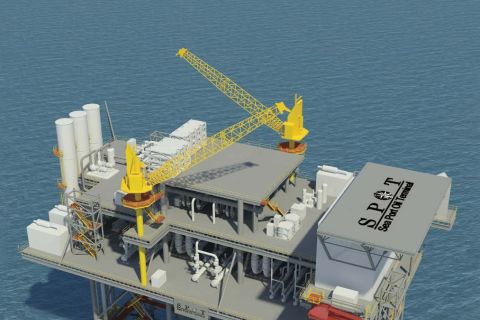Siberia is a million square miles of wilderness stretching across Asia from the Ural Mountains in the west to the Pacific Ocean, and from the Arctic Ocean to the borders of Kazakhstan, Mongolia and China. Unlike North America's sparsely settled Arctic regions, Siberia has many large industrial cities, mostly in the south, that are linked by the Trans Siberia Railroad. The northern part is home to vast oil and gas fields, as well as some of the world's richest reserves of coal, timber, platinum and nickel. In the north, the terrain is flat and consists of an ecosystem called "taiga" or boreal forest. Different from the tundra found in Alaska and Canada, some areas of taiga resemble infinite patterns of boggy ponds and grassy strips dotted with a few scraggly pine trees. Other areas contain seemingly endless forests. Huge oil fields were discovered there years ago by Soviet geologists. In the past, the state drilled thousands of wells at precise 250-meter intervals in grid-like patterns with little regard to subsurface geology or structure. As a result, some of the older fields were horrific in their disregard for the environment. Fields were hopelessly overdrilled, pressure was depleted and water levels rose. One field, the giant Samotlor, originally produced more than 100 million metric tons of oil per year when it was developed in the 1970s. Now it is 96% water and produces one-fifth as much oil. Nevertheless Siberia is estimated to contain more than 150 billion barrels of oil in place, nearly three times what has already been produced. Today, oil and gas operations are conducted from large, clean pads of sand and gravel. Field operations are well organized and businesslike and the environment is respected. Most of the newly privatized Russian oil companies are using Western technology to improve drilling success and production efficiency. Responsibility and teamwork characterize the relationships between Russian producers and Western service companies working there. In an area where much has gone wrong in the past, the new oil giants of Siberia are enjoying an unprecedented spirit of collaboration with their service partners. Most have negotiated comprehensive master service agreements that ensure expectations are met, on both sides. And the arrangements are not exclusive. Many producers have master agreements with several service providers. While these work well, the Western-style incentive agreement concept is experiencing slow acceptance. Still, many entrepreneurial leaders of service and oil companies are finding ways to work together for mutual benefit. Antonio Campo, Schlumberger president, Europe, Africa and the CIS, says, "It's quite simple. We will become 'Russians,' or Russian look-alikes, very quickly. This is a critical step for our success and the sooner we achieve it the better." To be able to take advantage of all the possibilities, complementary technology and techniques must be brought to the business, he adds. "In other words, we need to apply the value of fit-for-purpose technology." This requires understanding the market, its drivers and its economics. "Our approach will be to help change practices, to help change systems to work more efficiently, but not to overwhelm them with technology." Many Russian resources are available, and must be understood to motivate and manage them. "So that is key for us-to be able to understand the Russians, and in the balance, use what they have and complement it." Patrick Schorn, Moscow-based Schlumberger geomarket manager whose division includes 3,000 employees, among whom almost 95% are from Russia, agrees. "It's a myth that everyone here is standing in line for a few pieces of bread. That may have been true in the past, but it's finished now. This country has huge potential. Moscow has been called the 'Paris of the North.' And this is correct. "You can get anything here, as you would in any other big city. Sure there are still some people who are poor, but with a highly educated workforce and lots of opportunities developing every day, it is a very healthy business climate." The Network of Excellence for Training (NExT) initiative sponsored by Schlumberger in collaboration with Texas A&M, the University of Oklahoma and Heriot-Watt University of Edinburgh, Scotland, is conducting skills assessment, classes, workshops and distance learning all over Russia. Many talented scientists are available in Russia because of the closing of the big state labs. Schlumberger has more than 250 of them working on 30 projects under the guidance of the company's research facility at Moscow State University. Russians still have great pride in developing science and technology. Schorn says, "If we're going to be successful in Russia, it's extremely important to build on the strengths of the existing oil field with the particular technology or technique that we're trying to bring in. There is a very good business to be had if you can complement the existing business with what you have, because the best economic solution is not replacing one with the other. It is clearly using the technology to add value, and that goes for anything you want to do here." Doing business in Russia has not been a "black gold rush," however. Rather, producers are meticulously going through their inventories, boosting production from wells with the highest potential and shutting in the dogs. For example, Yukos has demonstrated double-digit production growth during the past three years while trimming its active well inventory from 14,000 to 9,000. On the drilling side, scientific drilling using rotary steerable tools and geosteering has boosted average well production from about 800 barrels per day to more than 2,800, with some producing as much as 12,500 per day. A classic example is the 44-million-barrel Entelskaya Block prospect developed by the Yuganskneftegaz division of Yukos. Designed in 1996, the plan called for 57 vertical wells of which seven were to be injectors and 50 were to be producers. Total field production was forecast at 12,580 barrels per day, with depletion in 19 years. The field was actually developed using two strategically placed horizontal wells, saving $400 million in development costs. Total production from the two wells is 31,450 barrels per day, and field life is estimated at 7.6 years. Sibneft is a study in applied technology to drive efficiency. The company operates 30 oil fields from its Siberian center in Noyabrsk. Two of the most successful techniques to improve production involve hydraulic fracturing and geosteered horizontal wells. In the Sugmut Field, for example, the company estimates it can fully develop the field with 800 strategically placed and completed wells instead of the 1,500 wells in the original plan. By using new technology, more than 25% of Sibneft's total production comes from only 100 wells out of its total inventory of 4,000. Noyabrsk is on the southern edge of the autonomous region known as Yamalo-Nenets, named after the ethnic groups forming the indigenous population, and despite its large population, it is barely 25 years old. It was built when the Soviet Union was rapidly constructing infrastructure in Siberia to exploit the country's vast mineral resources. The two biggest employers are Sibneft and Gazprom, the state-operated gas producer. Characteristic of the era in which it was founded, the majority of the city's housing consists of five-story block apartment buildings. But unlike other Russian cities, in Noyabrsk the buildings are gaily painted with giant murals, giving the town a positive, cheery atmosphere. This is reflected in the friendly outgoing people, who go out of their way to welcome visitors from the West. Among the latest improvements is a new Western-style hospital that has been constructed using Canadian construction materials and technology. As with most cities in the Arctic, a government-run central utility plant provides electricity and hot water as well as piping and treatment of sewage. Shops and restaurants are starting to appear, and the city boasts a new music school and Russian Orthodox church. Noyabrsk is a young city; most of its residents are younger than 35 years. Young families mean lots of children, and the city leadership is working hard to improve the quality and quantity of recreational activities together with an excellent school system. With winter lasting eight months from October to May, maintaining public morale is always a priority. The long winters can be bitter, with temperatures reaching 58 degrees below zero Fahrenheit, but the summers can be very hot at 95 degrees Fahrenheit. Unfortunately, the central utility plant does not supply air conditioning. AN INTERVIEW As general director of Noyabrskneftegaz, a subsidiary of Sibneft, Mikhail Stavskiy is above all a businessman. The company is one of the largest in Western Siberia, employing more than 17,000 people. Oil and Gas Investor met with him recently in his modern offices in Noyabrsk, a city of around 105,000 just south of the Arctic Circle, and 2,500 miles east-northeast of Moscow. In 2000, the company grew 5.4%; in 2001, 20.2%; in 2002, 27.4%; and by nearly year-end 2003, 22%. At press time Stavskiy expected 2004 production to exceed that of 1989. Young and dynamic, the general director is very much a hands-on manager in a key position. Today, Sibneft derives 25% of its production from only 100 wells. The situation is challenging, and the company is applying a straightforward approach, using the latest available technology to drill highly productive wells, and optimizing production from existing wells. Encouraged by early success, Stavskiy is confident that he is moving in the right direction to continue as one of Russia's leading oil companies. "As for the future, our plans are more aggressive," he says. Investor These are exciting days for your company. How are you achieving these excellent results? Stavskiy Sibneft is one of the fastest-growing oil companies because of our aggressive policies for improving production. Noyabrskneftegaz has just celebrated its 20-year jubilee as a company. But the main changes regarding production approaches have been introduced in the past seven years since Noyabrskneftegaz became part of Sibneft. Our thinking was probably the most difficult part to be changed. Investor What changes have been made? Stavskiy We used to be a government enterprise. Now we are private, and we have been building our experience base since 1995. We are attracting the best service companies to work with us. We use new equipment and technologies as well as highly qualified people. Also we are actively training our employees now. Investor What companies are involved? Stavskiy We have very good relations with Schlumberger, as well as with KCA Deutag, BJ Services and Baker Hughes. All along we have been consolidating our relationships. For example, we used to work with Reda and Camco, but now they are a part of Schlumberger. This sort of integration always plays a very positive role with us. Investor What's your strategy? Stavskiy We are trying to increase drilling efficiency and improve production from existing wells. We are also reducing the number of wells to be drilled by doing more difficult drilling-horizontal and multilateral wells, for example. We will drill fewer, but better, wells. Investor And the results? Stavskiy During the past three years, production has doubled. Average production from our horizontal wells is 2,200 barrels per day. Some of our better horizontal wells are producing to 9,450 barrels per day. We did this using Western technology. This technology is more expensive but at the same time, more cost-efficient. Investor What are the challenges? Stavskiy Definitely, there are some challenges. Fortunately, our oil is of the best quality in all Russia. Reservoir pressures vary from field to field, but the average is 3,970 psi and we have no high-pressure, high-temperature wells. Presently, we pump our crude to Omsk and Moscow refineries. But there is still some potential. To improve production and efficiency, we are drilling new horizontal wells and sidetrack drilling from old wells; multilateral drilling; optimization of existing wells under production by electrical submersible pumps; and fracturing. We've just celebrated fracturing our 1,000th well. We are also conducting field studies, and creating a training manual to teach our people how to do field studies. The studies are very good quality. We find that we are able to drill very good wells with a better geological model. Also, we are making better use of existing well data to plan. We used to have data before, but it was not monitored or analyzed. Now we use data dynamically to drill our wells.
Recommended Reading
TC Energy's Keystone Oil Pipeline Offline Due to Operational Issues, Sources Say
2024-03-07 - TC Energy's Keystone oil pipeline is offline due to operational issues, cutting off a major conduit of Canadian oil to the U.S.
Pembina Pipeline Enters Ethane-Supply Agreement, Slow Walks LNG Project
2024-02-26 - Canadian midstream company Pembina Pipeline also said it would hold off on new LNG terminal decision in a fourth quarter earnings call.
TC Energy’s Keystone Back Online After Temporary Service Halt
2024-03-10 - As Canada’s pipeline network runs full, producers are anxious for the Trans Mountain Expansion to come online.
Enbridge Announces $500MM Investment in Gulf Coast Facilities
2024-03-06 - Enbridge’s 2024 budget will go primarily towards crude export and storage, advancing plans that see continued growth in power generated by natural gas.
Enterprise Gains Deepwater Port License for SPOT Offshore Texas
2024-04-09 - Enterprise Products Partners’ Sea Port Oil Terminal is located approximately 30 nautical miles off Brazoria County, Texas, in 115 ft of water and is capable of loading 2 MMbbl/d of crude oil.




